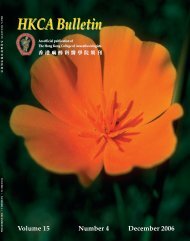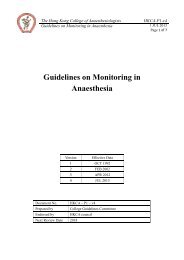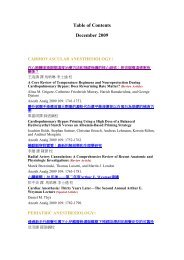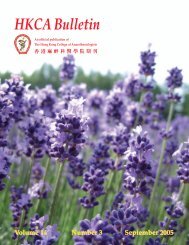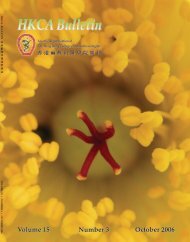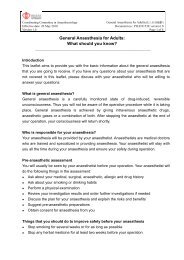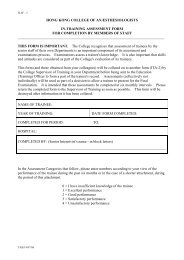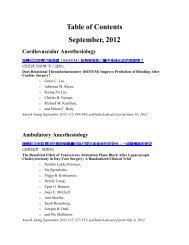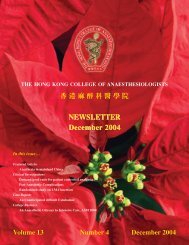HKCA Newsletter, Volume 11, No.1 - The Hong Kong College of ...
HKCA Newsletter, Volume 11, No.1 - The Hong Kong College of ...
HKCA Newsletter, Volume 11, No.1 - The Hong Kong College of ...
- No tags were found...
Create successful ePaper yourself
Turn your PDF publications into a flip-book with our unique Google optimized e-Paper software.
<strong>HKCA</strong> <strong>Newsletter</strong> <strong>Volume</strong> 13, Number 1 January, 2004CH 3HOH 3 CNHHNOO2H 2 OOFigure 3. AlvimopanGastrointestinal effectsOpioids decrease gastric emptying time, intestinal motility and cause constipation predominantly bya peripheral effect. Naloxone can successfully treat the constipation in patients with chronic opioid usebut with recurrence <strong>of</strong> pain and withdrawal symptoms. Methylnaltrexone, when given to patients withchronic methadone consumption, was able to improve gastric motility and relieve constipation withoutinducing withdrawal symptoms. Alvimopan has been shown to decrease the time for recovery <strong>of</strong> bowelfunction in patients with major bowel surgery. This may be associated with decreased time to hospitaldischarge. Alvimopan is also effective in relieving constipation in patients with chronic opioidconsumption.Nausea and vomitingOpioids induce nausea and vomiting by acting on the chemoreceptor trigger zone (CTZ) which liesoutside the BBB. Thus the CTZ is accessible to peripheral opioid antagonists. Initial data suggests thatboth methylnaltrexone and alvimopan can reduce postoperative nausea and vomiting. Since alvimopan ispoorly absorbed from the gastrointestinal tract, this reduction <strong>of</strong> nausea and vomiting is probablymediated in part by a peripheral mechanism.Other potential directionsPeripheral opioid antagonists may have a role in preventing the effects on patients withpostoperative ileus who receive exogenous opioids or in the intensive care unit where patients receiveopioids for sedation. <strong>The</strong> role <strong>of</strong> peripheral opiate antagonists in reversal <strong>of</strong> pruritis, biliary spasm,urinary retention secondary to opioids are as yet undefined. It has been speculated that peripheral opioidantagonists could reduce the depression <strong>of</strong> immune function that occurs with opioids. Respiratorydepression from overdose <strong>of</strong> opioids is a central effect. <strong>The</strong>refore, peripheral opioid antagonists wouldnot be expected to reverse this side effect.Selected referencesBates JJ, Foss JF, Murphy DB. Are peripheral opioid antagonists the solution to opioid side effects?Anesth Analg 2004;98:<strong>11</strong>6‐22Taguchi A. Sharma N. Saleem RM. Sessler DI. Carpenter RL. Seyedsadr M. Kurz A. Selectivepostoperative inhibition <strong>of</strong> gastrointestinal opioid receptors. N Engl J Med 2001;345:935‐4019




